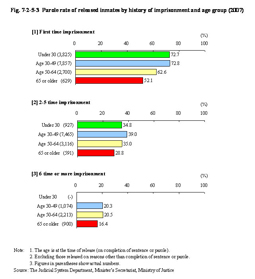| Previous Next Index Image Index Year Selection | |
|
|
2 Concrete image of elderly parolees The parole rate by age group and history of imprisonment in 2007 reveals the parole rate of elderly inmates to be lower than that of inmates under 65 years of age for each group of history of imprisonment. With inmates with a single history of imprisonment in particular the parole rate of the elderly group is about 20 points lower than that of age groups under 49 (see Fig. 7-2-5-3). Fig. 7-2-5-3 Parole rate of released inmates by history of imprisonment and age group (2007) By type of offense the parole rate for elderly inmates was lower for all four specific offenses described in the special research in Chapter 3, Section 2 of this Part, namely theft, injury/assault, and homicide, than that of age groups under 65 (see Fig. 7-2-5-4).Fig. 7-2-5-4 Parole rate of released inmates by type of offense, history of imprisonment, and age group (2007) As described above the parole rate for elderly inmates was lower than that of younger groups through analysis made from various points of view. The reason for this is that [1] first-time inmates may have had problems finding residences, etc. after release in that they had no guarantors to help them due to their advanced age and [2] those imprisoned multiple times and who had repeated crimes since a younger age would have the additional problem of being difficult to treat after release. Further research/analysis will be needed in the future to consider measures for supporting their rehabilitation and preventing them from repeating crimes. |

